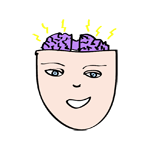Here you will find all the revision materials you need for OCR A2 Psychology, unit G543, and G544.
Understanding the categories of each study is vital to succeeding in your OCR A2 Psychology exam. Each unit has 4 main categories inside it. The bare minimum you have to learn is two units and three categories from each. For example let’s look at one unit: Forensic Psychology. You could pick to learn: Turning to Crime, Making a Case and Reaching a Verdict and you would not have to learn After a guilty verdict.
Forensic Psychology:
Turning to crime:
Upbringing:
Cognition:
Biology:
Making a case:
Interviewing Witnesses:
Interviewing Suspects:
Creating a Profile:
Reaching a Verdict:
Persuading a Jury:
Witness Appeal:
Reaching a Verdict:
After a Verdict:
Imprisonment:
Health and Clinical Psychology:
Health and Clinical is one of the units in OCR A2 Psychology Unit G543.
This page has been written to help you understand the structure of the health and clinical unit from your OCR A2 Psychology G543 exam.
In order to revise effectively for this Psychology exam you will need to know all the categories and subsections of this unit, as the questions you will be asked will relate directly to the categories first, not the studies as was the case in AS psychology, for example in your A2 Psychology exam you will never be asked a question with the name of a specific study in the question.
So to revise effectively, you will need to know all the categories. In the sidebar you will find a form to get a free Psych Yogi revision guide to further help you with you studies.
It is highly recommended that you buy the revision guide to help you with your learning process: OCR A2 Psychology Student Unit Guide New Edition: Unit G543 Health and Clinical Psychology (Student Unit Guides)
Health and Clinical Psychology Studies:
Healthy Living:
Theories of health belief:
Methods of health promotion and supporting evidence:
- Cowpe (1989) – Media Campaign
- Dannenberg (1993) – Legislation
- Janis and Feshbach (1953) – Fear Arousal
Features of adherence to medical regimes and supporting evidence:
- Bulpitt and Fletcher (1988) – Reasons for non-adherence: cognitive rational non-adherence
- Lustman (2000) – Measures of non-adherence: physiological
- Watt et al (2003) – Improving – Behavioural (Funhaler)
Causes of stress:
- Johansson et al., (1978) – Work
- Kanner (1981) – Hassles and Life Events
- Geer and Maisel (1972) – Lack of Control
Methods of measuring stress:
- Geer and Maisel (1972) – Physiological Measures
- Holmes and Rahe (1967) – Self-report
- Johansson et al., (1978) – Combined Approach
Techniques for managing stress:
Dysfunctional Behaviour:
Diagnosis of dysfunctional behaviour:
- DSM/ICD – Categorising
- Rosenhan and Seligman (1989) – Definitions
- Ford and Widiger (1989) – Biases in Diagnosis
Explanations of dysfunctional behaviour:
- Gottesman and Shields (1972) – Biological
- Watson and Raynor Little Albert (1920) – Behavioural
- Beck (1967) – Cognitive – Maladaptive Thoughts
Treatments of dysfunctional behaviour:
- Karp and Frank (1995) – Biological
- McGrath et al (1990) – Behavioural
- Öst and Westling (1995) – Cognitive Behavioural Therapy
Disorders:
Characteristics of disorders:
- Phobia – An anxiety Disorder
- A Psychotic Disorder – Schizophrenia
- An Affective Disorder – Bipolar
Explanations of one disorder (affective, anxiety or psychotic):
- Watson and Raynor Little Albert (1920) – Behavioural
- Gottesman and Shields (1972) – Biological
- Seligman (1979) – Cognitive
Treatments of one disorder (affective, anxiety of psychotic):
- Paul and Lentz (1977) – Behavioural
- Comer (1998) – Cognitive Behavioural Therapy
- Karp and Frank (1995) – Biological

I was just looking through some of these studies and at the top it says as a bare minimum you have to know 2 units so I’ve been taught Forensic and Health and Clinical, and then you only have to know 3 categories e.g. Making a case, Reaching a verdict and After a guilty verdict. Why is this? Just for clarification I could get away with only revising those categories? Why could I leave one out?
In the exam you have the option to choose 2 of 4 questions per unit. There is a chance that they will ask two questions on two sections, therefore you need to learn a minimum of 3 sections to ensure that you can answer at least two of the option in the exam. Learning only 3 sections per unit may leave you with no choice of the questions you can answer.